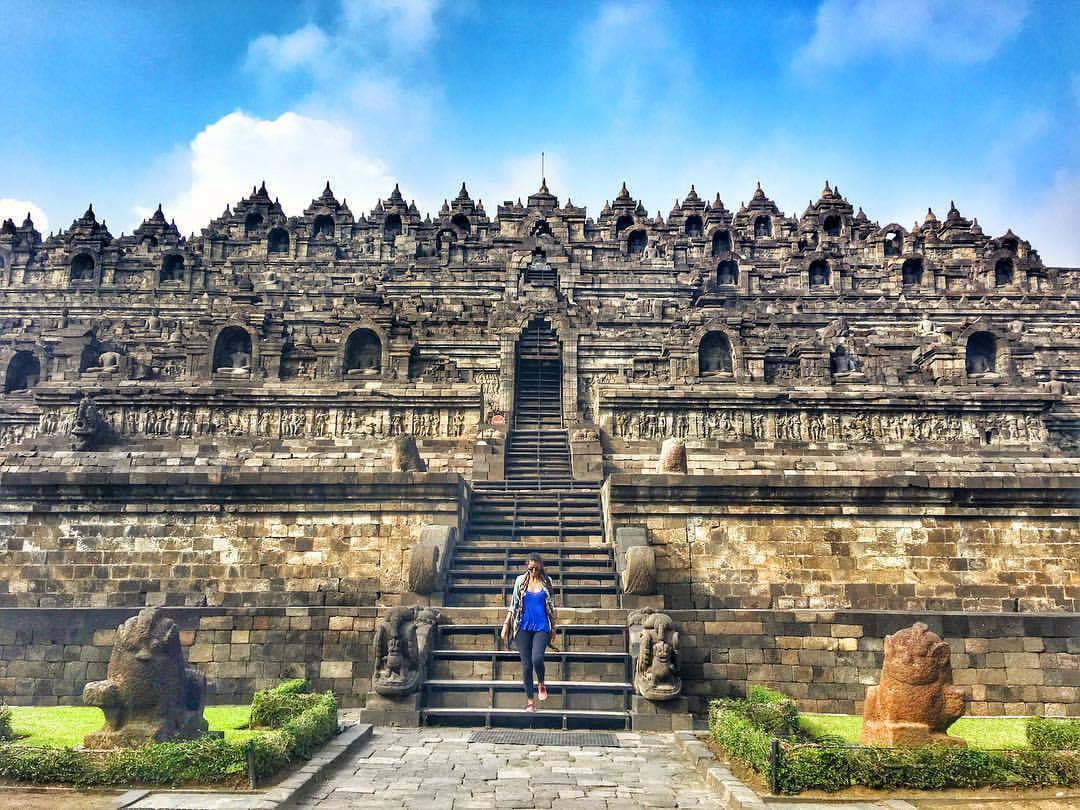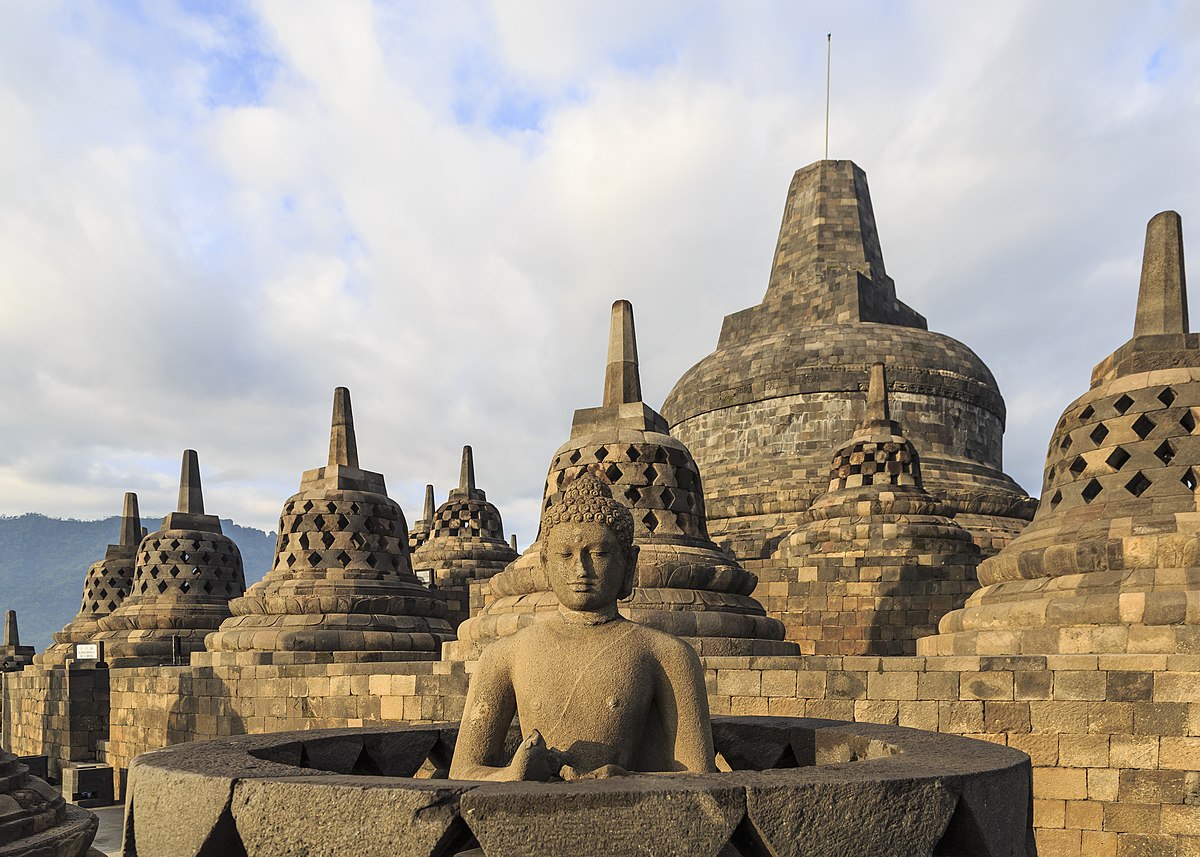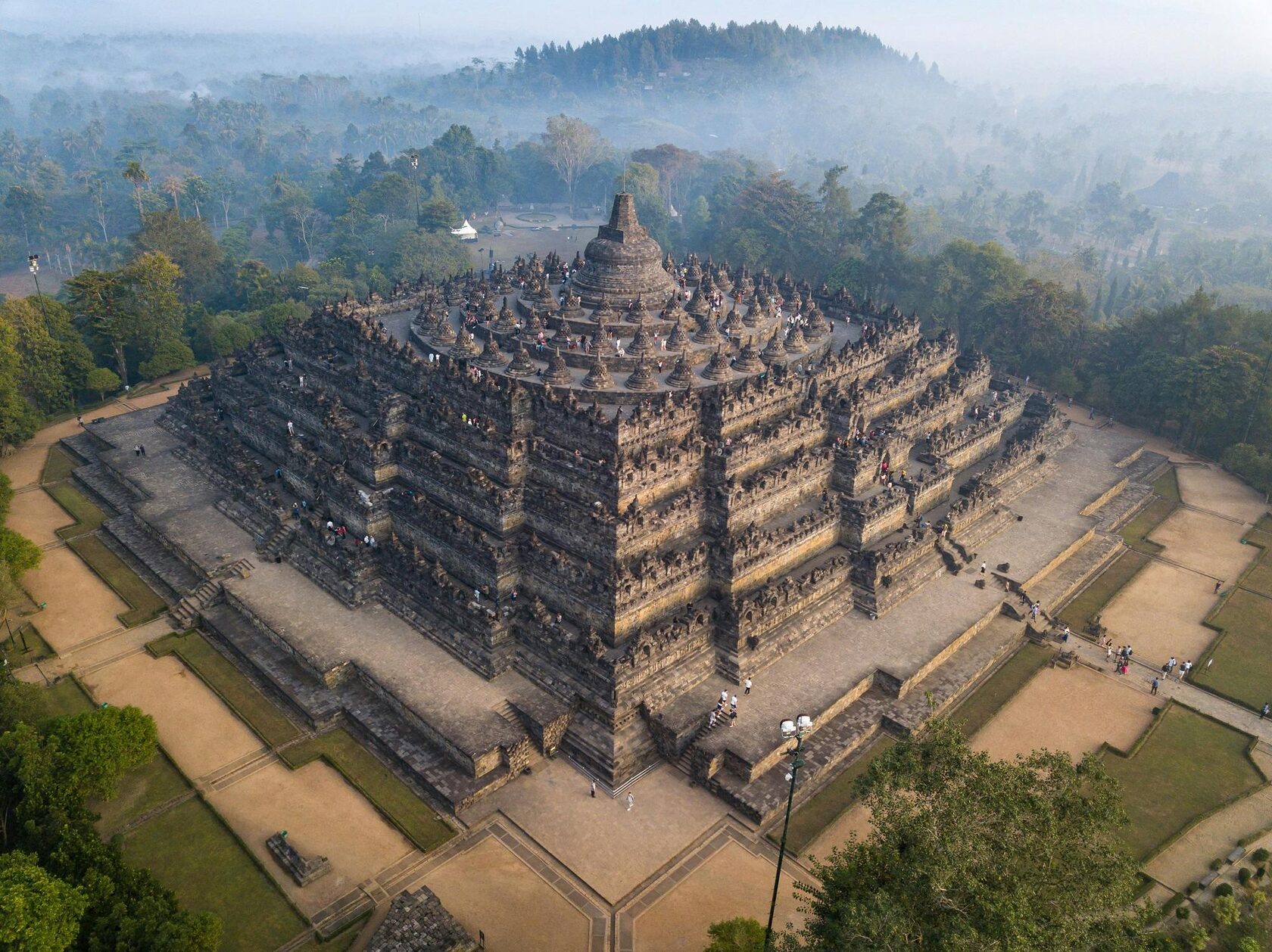Borobudur Temple
Borobudur is a grandiose structure located in the central part of the island of Java. This is the largest Buddhist temple in the world, which has become the most important cultural and architectural monument. Since 1991, Borobudur has been included in the UNESCO World Heritage List. The complex is famous for its scale, unique architecture and the largest collection of Buddhist reliefs on the planet. Millions of tourists and pilgrims come here every year.
Geographical Location of the Temple
Borobudur is situated on a hill in the Magelang Regency, Borobudur Village, in the central part of Java. The complex lies:
• 100 km southwest of Semarang
• 86 km west of Surakarta
• 40 km northwest of Yogyakarta
The temple stands on the Kedu Plain, encircled by volcanoes:
• To the northwest are Mount Sindoro and Mount Sumbing.
• To the northeast are Mount Merbabu and the active Mount Merapi.
• To the south is the Menoreh Range, which legend says represents the sleeping body of the temple’s architect, Gunadharma.
The Kedu Plain is celebrated for its natural beauty and fertile soil. It is considered sacred and referred to as the “Garden of the Island of Java.” To the southeast, it borders the Kewu Plain, the site of the Prambanan Temple.
Name of the Temple
The exact origin of the name “Borobudur” remains unknown, with several theories in circulation:
1. Great Buddha: Derived from “Boro” (great) and “Budur” (Buddha).
2. Ancient Boro: Sir Thomas Raffles suggested that the name is associated with the locality, meaning “ancient Boro.”
3. Mount Boro: Taken from the Javanese word “bhudhara,” meaning “mountain.”
4. Buddhist Vihara on High: According to August Kempers, the name comes from the Sanskrit “Vihara Buddha Uhr.”
5. Bhumisambharabudhara: Archaeologist Johannes de Casparis proposed this as the temple’s full name, meaning “The Mountain of the Accumulation of Virtues of the Ten Stages of a Bodhisattva.”
Influence and Symbolism
Borobudur is not only an architectural masterpiece but also a symbol of Buddhist philosophy. It embodies a cosmic model of the universe, with each level of the temple corresponding to a stage of spiritual development. Its name, location, and unique design make Borobudur one of Indonesia’s most significant monuments.
Borobudur is situated on a hill in the Magelang Regency, Borobudur Village, in the central part of Java. The complex lies:
• 100 km southwest of Semarang
• 86 km west of Surakarta
• 40 km northwest of Yogyakarta
The temple stands on the Kedu Plain, encircled by volcanoes:
• To the northwest are Mount Sindoro and Mount Sumbing.
• To the northeast are Mount Merbabu and the active Mount Merapi.
• To the south is the Menoreh Range, which legend says represents the sleeping body of the temple’s architect, Gunadharma.
The Kedu Plain is celebrated for its natural beauty and fertile soil. It is considered sacred and referred to as the “Garden of the Island of Java.” To the southeast, it borders the Kewu Plain, the site of the Prambanan Temple.
Name of the Temple
The exact origin of the name “Borobudur” remains unknown, with several theories in circulation:
1. Great Buddha: Derived from “Boro” (great) and “Budur” (Buddha).
2. Ancient Boro: Sir Thomas Raffles suggested that the name is associated with the locality, meaning “ancient Boro.”
3. Mount Boro: Taken from the Javanese word “bhudhara,” meaning “mountain.”
4. Buddhist Vihara on High: According to August Kempers, the name comes from the Sanskrit “Vihara Buddha Uhr.”
5. Bhumisambharabudhara: Archaeologist Johannes de Casparis proposed this as the temple’s full name, meaning “The Mountain of the Accumulation of Virtues of the Ten Stages of a Bodhisattva.”
Influence and Symbolism
Borobudur is not only an architectural masterpiece but also a symbol of Buddhist philosophy. It embodies a cosmic model of the universe, with each level of the temple corresponding to a stage of spiritual development. Its name, location, and unique design make Borobudur one of Indonesia’s most significant monuments.

Architectural Features and Symbolism
Borobudur is a terraced pyramid with nine levels: six lower square tiers and three circular tiers on top, crowned by a large central stupa. Its total height is 35.4 meters (42 meters if the lost umbrella-shaped chattra is included), and the base measures 123 x 123 meters.
• Building Material: The temple was constructed with andesite, a sturdy volcanic rock. Over two million blocks were laid without mortar, using a “dovetail” technique.
• Design: Viewed from above, the temple resembles a Buddhist mandala—a cosmic diagram combining squares and concentric circles. The upper stupas symbolize the transition to a spiritual realm.
• Tiers:
• Base (Kamadhatu) represents the world of passion and desire.
• Body (Rupadhatu) represents the world of forms, dominated by appearances.
• Upper Levels (Arupadhatu) represent the formless realm, free from attachments.
Reliefs and Statues
The temple walls feature 2,672 relief panels depicting scenes from the life of the Buddha, jatakas (Buddha’s past-life stories), and various legends. Together, these reliefs stretch over 2.5 km in length and contain more than 10,000 figures.
• At the Rupadhatu levels, there are 432 Buddha statues in different mudras (hand gestures). Originally, the temple contained 504 Buddha statues in total, though some have been lost.
History
• 8th–9th Centuries: Borobudur was built during the reign of the Buddhist Shailendra dynasty. Its construction likely took around 75–100 years.
• 11th Century: Eruptions of Mount Merapi and other factors forced inhabitants to abandon the area. The temple was left deserted and buried under layers of volcanic ash.
• 1814: Thomas Raffles, then the British governor of Java, rediscovered Borobudur. Excavations began under Herman Cornelius.
• 1907–1911: The first major restoration was carried out by the Dutch engineer Theodoor van Erp.
• 1975–1982: A large-scale restoration project, supported by UNESCO, included reinforcing the foundation and installing a drainage system.
Modern Significance
Borobudur was inscribed as a UNESCO World Heritage Site in 1991. It serves as a key symbol of Buddhism and a major pilgrimage destination. Celebrations such as Vesak draw Buddhists from around the globe.
• Tourism: Around two million people visit annually. In 2020, daily visitor numbers were capped at 1,200 to protect the monument.
• Threats: Mount Merapi remains a concern. Its last major eruption in 2010 caused damage to the temple.
Park Complex and Museums
• Karmavibhangga Museum: Displays archaeological finds and pieces of relief panels.
• Samudra Raksa Ship Museum: Highlights the region’s maritime history and showcases a reconstruction of an ancient ship.
• Dagi Hill Viewpoint: An ideal spot for panoramic views of the temple.
Borobudur stands not only as a cultural treasure but also as a living shrine where the past meets the present.
Borobudur is a terraced pyramid with nine levels: six lower square tiers and three circular tiers on top, crowned by a large central stupa. Its total height is 35.4 meters (42 meters if the lost umbrella-shaped chattra is included), and the base measures 123 x 123 meters.
• Building Material: The temple was constructed with andesite, a sturdy volcanic rock. Over two million blocks were laid without mortar, using a “dovetail” technique.
• Design: Viewed from above, the temple resembles a Buddhist mandala—a cosmic diagram combining squares and concentric circles. The upper stupas symbolize the transition to a spiritual realm.
• Tiers:
• Base (Kamadhatu) represents the world of passion and desire.
• Body (Rupadhatu) represents the world of forms, dominated by appearances.
• Upper Levels (Arupadhatu) represent the formless realm, free from attachments.
Reliefs and Statues
The temple walls feature 2,672 relief panels depicting scenes from the life of the Buddha, jatakas (Buddha’s past-life stories), and various legends. Together, these reliefs stretch over 2.5 km in length and contain more than 10,000 figures.
• At the Rupadhatu levels, there are 432 Buddha statues in different mudras (hand gestures). Originally, the temple contained 504 Buddha statues in total, though some have been lost.
History
• 8th–9th Centuries: Borobudur was built during the reign of the Buddhist Shailendra dynasty. Its construction likely took around 75–100 years.
• 11th Century: Eruptions of Mount Merapi and other factors forced inhabitants to abandon the area. The temple was left deserted and buried under layers of volcanic ash.
• 1814: Thomas Raffles, then the British governor of Java, rediscovered Borobudur. Excavations began under Herman Cornelius.
• 1907–1911: The first major restoration was carried out by the Dutch engineer Theodoor van Erp.
• 1975–1982: A large-scale restoration project, supported by UNESCO, included reinforcing the foundation and installing a drainage system.
Modern Significance
Borobudur was inscribed as a UNESCO World Heritage Site in 1991. It serves as a key symbol of Buddhism and a major pilgrimage destination. Celebrations such as Vesak draw Buddhists from around the globe.
• Tourism: Around two million people visit annually. In 2020, daily visitor numbers were capped at 1,200 to protect the monument.
• Threats: Mount Merapi remains a concern. Its last major eruption in 2010 caused damage to the temple.
Park Complex and Museums
• Karmavibhangga Museum: Displays archaeological finds and pieces of relief panels.
• Samudra Raksa Ship Museum: Highlights the region’s maritime history and showcases a reconstruction of an ancient ship.
• Dagi Hill Viewpoint: An ideal spot for panoramic views of the temple.
Borobudur stands not only as a cultural treasure but also as a living shrine where the past meets the present.

Borobudur Temple is located here
